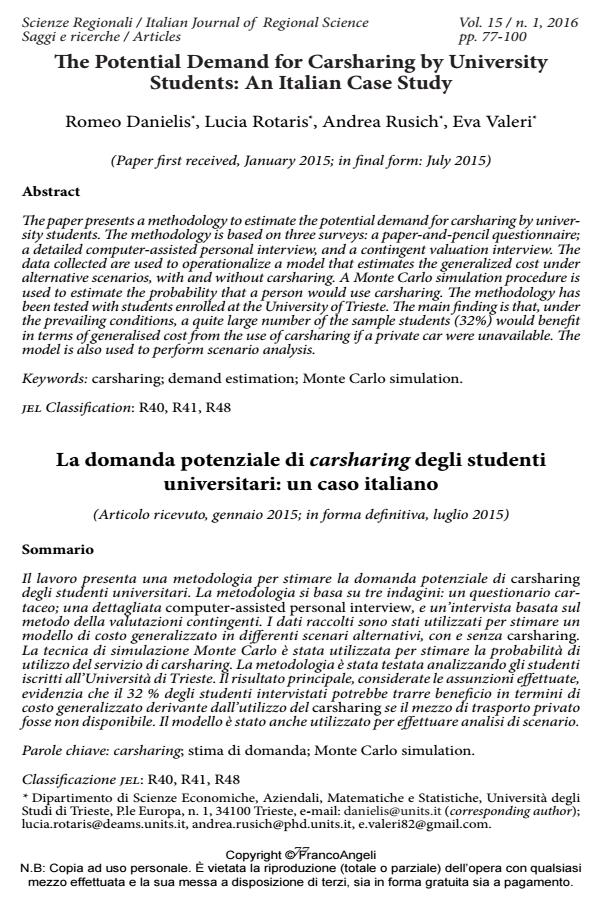The Potential Demand for Carsharing by University Students: An Italian Case Study
Titolo Rivista SCIENZE REGIONALI
Autori/Curatori Romeo Danielis, Lucia Rotaris, Andrea Rusich, Eva Valeri
Anno di pubblicazione 2016 Fascicolo 2016/1
Lingua Inglese Numero pagine 23 P. 77-99 Dimensione file 271 KB
DOI 10.3280/SCRE2016-001004
Il DOI è il codice a barre della proprietà intellettuale: per saperne di più
clicca qui
Qui sotto puoi vedere in anteprima la prima pagina di questo articolo.
Se questo articolo ti interessa, lo puoi acquistare (e scaricare in formato pdf) seguendo le facili indicazioni per acquistare il download credit. Acquista Download Credits per scaricare questo Articolo in formato PDF

FrancoAngeli è membro della Publishers International Linking Association, Inc (PILA)associazione indipendente e non profit per facilitare (attraverso i servizi tecnologici implementati da CrossRef.org) l’accesso degli studiosi ai contenuti digitali nelle pubblicazioni professionali e scientifiche
The paper presents a methodology to estimate the potential demand for carsharing by university students. The methodology is based on three surveys: a paper-and-pencil questionnaire; a detailed computer-assisted personal interview, and a contingent valuation interview. The data collected are used to operationalize a model that estimates the generalized cost under alternative scenarios, with and without carsharing. A Monte Carlo simulation procedure is used to estimate the probability that a person would use carsharing. The methodology has been tested with students enrolled at the University of Trieste. The main finding is that, under the prevailing conditions, a quite large number of the sample students (32%) would benefit in terms of generalised cost from the use of carsharing if a private car were unavailable. The model is also used to perform scenario analysis.
Il lavoro presenta una metodologia per stimare la domanda potenziale di carsharing degli studenti universitari. La metodologia si basa su tre indagini: un questionario cartaceo; una dettagliata computer-assisted personal interview, e un’intervista basata sul metodo della valutazioni contingenti. I dati raccolti sono stati utilizzati per stimare un modello di costo generalizzato in differenti scenari alternativi, con e senza carsharing. La tecnica di simulazione Monte Carlo è stata utilizzata per stimare la probabilità di utilizzo del servizio di carsharing. La metodologia è stata testata analizzando gli studenti iscritti all’Università di Trieste. Il risultato principale, considerate le assunzioni effettuate, evidenzia che il 32 % degli studenti intervistati potrebbe trarre beneficio in termini di costo generalizzato derivante dall’utilizzo del carsharing se il mezzo di trasporto privato fosse non disponibile. Il modello è stato anche utilizzato per effettuare analisi di scenario.
Parole chiave:Carsharing; stima di domanda; Monte Carlo simulation.
Jel codes:R40, R41, R48
- An extended theory of planned behavior to explain the intention to use carsharing: a multi-group analysis of different sociodemographic characteristics Leiming Li, Yu Zhang, in Transportation /2023 pp.143
DOI: 10.1007/s11116-021-10240-1 - The Potential Demand for Carsharing by University Students: An Italian Case Study Romeo Danielis, Lucia Rotaris, Andrea Rusich, Eva Valeri, in SCIENZE REGIONALI 1/2016 pp.77
DOI: 10.3280/SCRE2016-001004 - Intention of Chinese college students to use carsharing: An application of the theory of planned behavior Yu Zhang, Leiming Li, in Transportation Research Part F: Traffic Psychology and Behaviour /2020 pp.106
DOI: 10.1016/j.trf.2020.09.021 - Carsharing use by college students: The case of Milan and Rome Lucia Rotaris, Romeo Danielis, Ila Maltese, in Transportation Research Part A: Policy and Practice /2019 pp.239
DOI: 10.1016/j.tra.2018.12.017 - 2019 6th International Conference on Models and Technologies for Intelligent Transportation Systems (MT-ITS) Stefano Carrese, Ernesto Cipriani, Tommaso Giacchetti, Eleonora Sottile, Leonardo Zamberlan, pp.1 (DOI:10.1109/MTITS.2019.8883317)
Romeo Danielis, Lucia Rotaris, Andrea Rusich, Eva Valeri, The Potential Demand for Carsharing by University Students: An Italian Case Study in "SCIENZE REGIONALI " 1/2016, pp 77-99, DOI: 10.3280/SCRE2016-001004